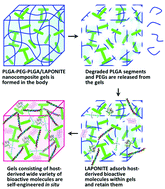Nanocomposite injectable gels capable of self-replenishing regenerative extracellular microenvironments for in vivo tissue engineering†
Abstract
Injectable hydrogels are biomaterials that have the potential to provide scaffolds to cells for in situ tissue regeneration with a minimally invasive implantation procedure. The success of in vivo tissue engineering utilizing injectable gels depends on providing cells with appropriate scaffolds that present an instructive extracellular microenvironment, which strongly influences the survival, proliferation, organization, and function of cells encapsulated within gels. One of the most important abilities of injectable gels to achieve this function is to adsorb and retain a wide variety of requisite bioactive molecules including nutrients, extracellular matrices, and growth/differentiation factors within gels. Previously, we developed nanocomposite injectable gels fabricated by simple combination of common biodegradable copolymers, poly(lactide-co-glycolide)-b-poly(ethylene glycol)-b-poly(lactide-co-glycolide) (PLGA-PEG-PLGA), and synthetic clay nanoparticles (LAPONITE®). We revealed that the nanocomposite injectable gels strongly adsorb ECM molecules including collagen and heparin within gels and retain them due to the ability of LAPONITE® in synchronization with the degradation of PLGA-PEG-PLGA and subsequent release of the degradation products. Human dermal fibroblast cells cultured on the nanocomposite gels showed enough high cell viability and proliferation for at least a week. Moreover, various kinds of human cells encapsulated within the nanocomposite gels exhibited significantly higher survival, proliferation, and three-dimensional organization in comparison with the PLGA-PEG-PLGA gel, LAPONITE® gel, and Matrigel. Furthermore, transplantation of mouse myoblast cells with the nanocomposite gels in model mice of skeletal muscle injury dramatically enhanced tissue regeneration and functional recovery, whereas cell transplantation with the PLGA-PEG-PLGA gel did not. Thus, the nanocomposite injectable gels possess unique abilities to self-replenish the regenerative extracellular microenvironment within the gels in the body, demonstrating the potential utility of the nanocomposite injectable gels for in vivo tissue engineering.



 Please wait while we load your content...
Please wait while we load your content...